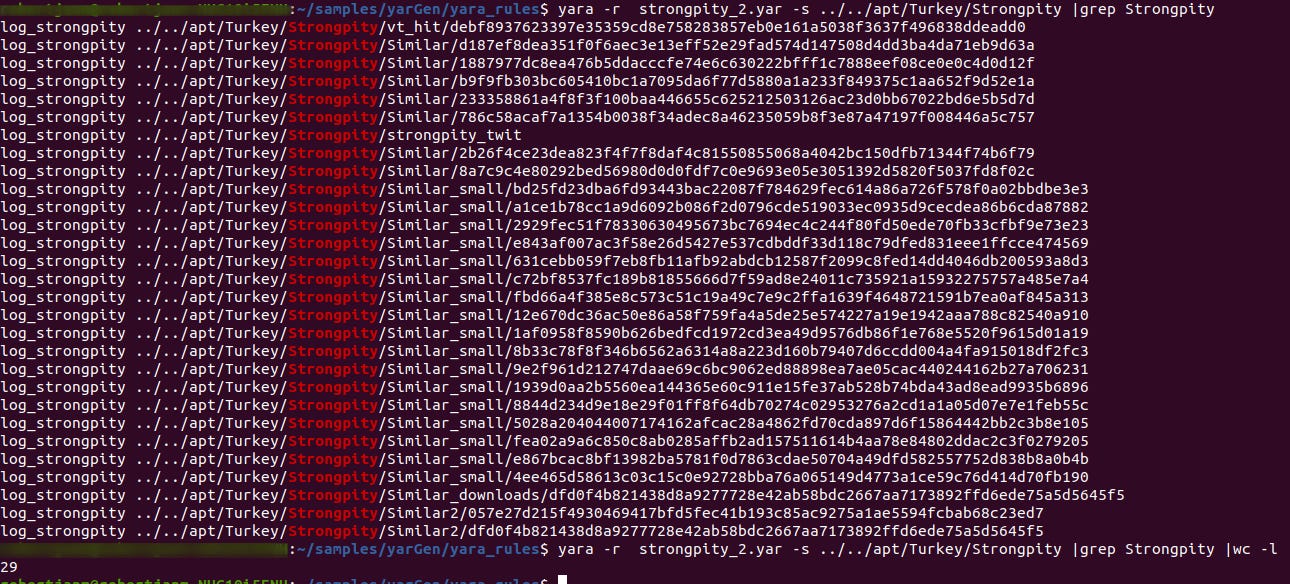Tracking StrongPity with Yara
Alleged Turkish nation-state actor keeps infecting victims with trojanized software
Disclaimer: The views, methods, and opinions expressed at Anchored Narratives are those of the author and do not necessarily reflect the official policy or position of my employer.
Introduction
Here’s the latest Anchored Narrative with a follow-up story on the alleged Turkish nation-state actor StrongPity. Thanks for being a subscriber, and welcome to the new subscribers. As always, if you have any tips, comments, or great examples of disputed threat intelligence narratives for me, send them to robertjanm@anchorednarratives.com. Anchored Narratives is now also on Twitter @AnchoredNarrat1.
In the previous article about StrongPity, their history of used malware and their preferred malware infection method were covered. This article will outline how you can track a nation-state actor by leveraging the power of Yara. Yara is called the pattern matching Swiss army knife for malware researchers and is under constant development providing new features. After the last article in April 2021 on StrongPity, I developed a custom Yara signature (rule) to determine if it could track new campaigns or activity used by this nation-state actor. In this article, I will cover the creation of custom Yara rules with the well-known IDA disassembler, test them, implement them on VirusTotal Intelligence or Malpedia and perform a retrohunt. I will not cover the basics of Yara or how basic rules are constructed. Let’s go!
VirusTotal Intelligence
As explained in one of the first articles on Anchored Narratives is that you can implement threat intelligence on many different sources. One of these sources is newly submitted malware samples on VirusTotal or Malpedia that are matched against custom Yara rules implemented by malware or threat analysts that track ransomware or nation-state actors. VirusTotal Intelligence (hereafter: VTI) is a paid service. The platform provides access to a large corpus of submitted malware or viruses by users or companies. The samples are stored for a longer period of time. VTI is being used by security researchers for threat hunting or finding similar files or known exploits. Researchers can basically implement alarms with Yara rules on known exploits, ransomware, or malware used by nation-state actors.
So after a period of StrongPity silence since the end of April 2021, last week, I received an alert on a new sample that matched my custom, Yara rule. The details of the malware sample can be seen in the figure below.
SHA256:debf8937623397e35359cd8e758283857eb0e161a5038f3637f496838ddeadd0
C2: https://informationserviceslab.com/parse_ini_file.php IP:45.153.243.141This time the malware sample reached out to the command and control server ”https://informationserviceslab.com”, which was not known by me yet. But what triggered the Yara rule, and how was the rule built? VirusTotal provides functionality that highlights the matched context of the Yara rule. As you might recall from the last article, the StrongPity malware has quite some interesting ‘strings’ that could be leveraged in a Yara rule and XOR routines to decrypt the encoded domain name, etc. Figure 2 highlights a specific hex pattern below that starts with “66 31 BC 45”, reflecting such a routine. The Yara rule was triggered because of the three matching elements in the rule.
The Yara rule was triggered because of the three matching elements in the rule. But how was this high-fidelity Yara rule build? Let’s dive into that.
Building the Yara rule
As mentioned earlier, VirusTotal Intelligence provides powerful functionality to search for similar samples. Based on earlier StrongPity reporting by ESET and CitizenLab, multiple samples were downloaded with the intent to track StrongPity.
In an in-company Yara training delivered by well-known security researcher Andreas Schuster many years ago, his advice was to focus on custom implementations of algorithms or routines by actors as a way to track adversaries. He demonstrated great examples back then to track specific Chinese nation-state actors. With that advice in mind, I started building the Yara rule to see if there was an additional way to track them. One way to assess these discriminating artifacts is by leveraging IDA in this example. Before we start, make sure you enabled the amount of opcodes bytes (machine code) displayed in IDA7 (free). This is a method to highlight potential repetitive or certain uniqueness in relevant malware samples.
In this article, only several of the many StrongPity samples are covered and explained below.
Strongpity:b9f9fb303bc605410bc1a7095da6f77d5880a1a233f849375c1aa652f9d52e1aStrongPity usually holds several XOR-routines with different XOR values to decode different information stored in each sample. This was covered in the earlier piece on StrongPity. So open the malware sample in IDA and determine if you could distinguish a unique routine from the actor. One of the XOR decoding routines is highlighted below.
Could we make a Yara pattern of this routine? In the screenshot above, you can see an opcode byte pattern that starts with “66 83 B4 45 FC FE” and ends with the bytes “72 F1”. Let’s examine the next sample.
StrongPity:8a7c9c4e80292bed56980d0d0fdf7c0e9693e05e3051392d5820f5037fd8f02cIn this different sample, you notice a similar sequence of opcode byte patterns. After this, I examined some other samples and came up with the following Yara patterns to match StrongPity samples.
$opcodexor1 = {66 31 ?? ?5 ?? F? FF FF 4? 83 F? ?? 72 F?} $opcodexor2 = {66 83 B4 ?5 ?? F? FF FF [2-5] 72 F?}Within Yara, you can match on strings “text” or patterns in its hexadecimal form. So with the above instructions, Yara will match against the routine found in the StrongPity malware samples. The “??” values are a wildcard and match any value. The values between the square brackets separated by a hyphen [-], are seen as a jump and match an arbitrary sequence from 4 to 5 bytes. By themselves, only those XOR patterns would trigger too many false positives. So, normally you would also leverage some telling strings found in malware samples to strengthen the Yara rule and really zoom in on a certain actor. This will reduce the number of false positives or false negatives. The StrongPity samples that I analyzed hold many of those telling strings. A very nice tool developed by Florian Roth called YarGen was leveraged to find those patterns automatically. After a bit of testing, the following StrongPity Yara rule was created, listed below, and implemented on VTI.
rule log_strongpity {
meta:
description = "Strongpity - xor routine.txt"
author = "RJM"
date = "2021-04-20"
strings:
$s1 = "Content-Disposition: form-data; name=\"file\"; " fullword ascii
$s2 = "Content-Type: multipart/form-data; boundary=----Boundary%08X" fullword wide
$s3 = "SecurityHost.exe" fullword wide
$s4 = "-CreateMutexW" fullword ascii
$s5 = "name=%ls&delete=WinHttpWriteDataWinHttpQueryHeadWinHttpCloseHandWinHttpReceiveReWinHttpOpenRequeWinHttpQueryOptiWinHttpSetOption" ascii
$s6 = "Windows Security Host" fullword wide
$opcodexor1 = {66 31 ?? ?5 ?? F? FF FF 4? 83 F? ?? 72 F?}
$opcodexor2 = {66 83 B4 ?5 ?? F? FF FF [2-5] 72 F?}
condition:
( uint16(0) == 0x5a4d and filesize < 200KB and ( 3 of them )
) or ( all of them )
}Testing the StrongPity Yara rule
As I wrote earlier, I downloaded 29 StrongPity samples previously via the similarity search functionality in VirusTotal Intelligence. So let’s test if the rule is reliable enough to detect the samples. All the samples are stored in different directories underneath the “apt/Turkey/Strongpity” folder.
Figure 5 highlights Yara matches on the decoding routines found in the IDA disassembler. Now let’s see how many samples are detected with the manually created Yara rule.
The StrongPity Yara rule matched exactly 29 samples. After testing it on other malware samples, the rule seems solid and did not produce any false positives. So basically, the next step is to implement the Yara rule as a live hunt rule in VirusTotal Intelligence. This resulted in the match of a brand new StrongPity sample covered in the introduction of this article. The reason for implementing it first as a live hunt rule is to assess if it generates false positives or false negatives on that platform. I have made many mistakes in the past where I deployed a too generic rule. So testing and validating are very important.
Retrohunting StrongPity
For paid subscribers or researchers, VirusTotal Intelligence provides a capability to search across multiple samples. For regular users, the corpus of malware samples that are searched is 3 months. If you are a pro user, you can search the entire corpus for the past 12 months. Retrohunts are usually limited and expensive searches. Similar searches can be conducted on Malpedia or other platforms supporting Yara rules and storing historical malware samples.
So after I verified the rule, the StrongPity retrohunt was executed. After a while, the rule matched 127 StrongPity samples in the past 12 months. Only 9 in the past 3 months.
Upon inspection, none of the 9 samples that matched were false positives. Maybe someone with VTI pro access can run the StrongPity retrohunt to obtain the full results for further assessment? Reach out if you were able to obtain all samples and if there were any false positives.
Conclusion
Yara is a good way to distinguish between malware of a given family and other files based on known patterns and obtain intelligence on relevant nation-state actors or ransomware actors. In this article, I outlined a method to build a discriminating Yara rule that was leveraged to track a known nation-state adversary, in this case, the alleged Turkish actor group StrongPity. The rule was also used to perform a successful retrohunt. With the StrongPity Yara rule, we can track new malware samples of the actor and collect many historical samples for the past year(s). There could also be other routines leveraged by StrongPity that discriminate and provide even better insights into how big their spyware campaigns are. That said, finding 127 malware samples submitted to VirusTotal in the past 12 months with a custom build Yara rule indicates the rule has high fidelity and that the actors behind StrongPity must be collecting massive amounts of personal data. I’m curious about how this data collected from different victims in countries around the globe is processed.
The StrongPity actor remains very active and obtains new infrastructure per campaign, it seems. The next threat actor that will be covered as an Anchored Narrative is from the Asia-Pacific region. Until next time and reach out if you want to share different or additional insights or feedback.












